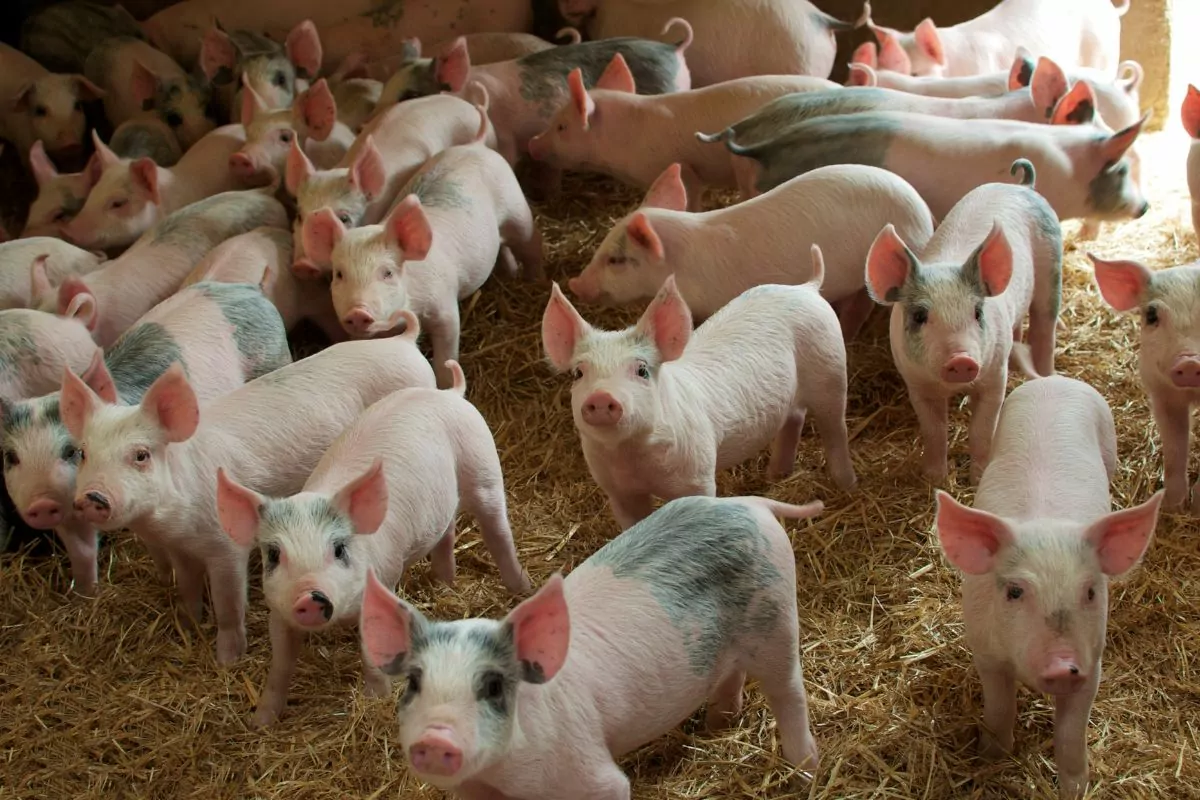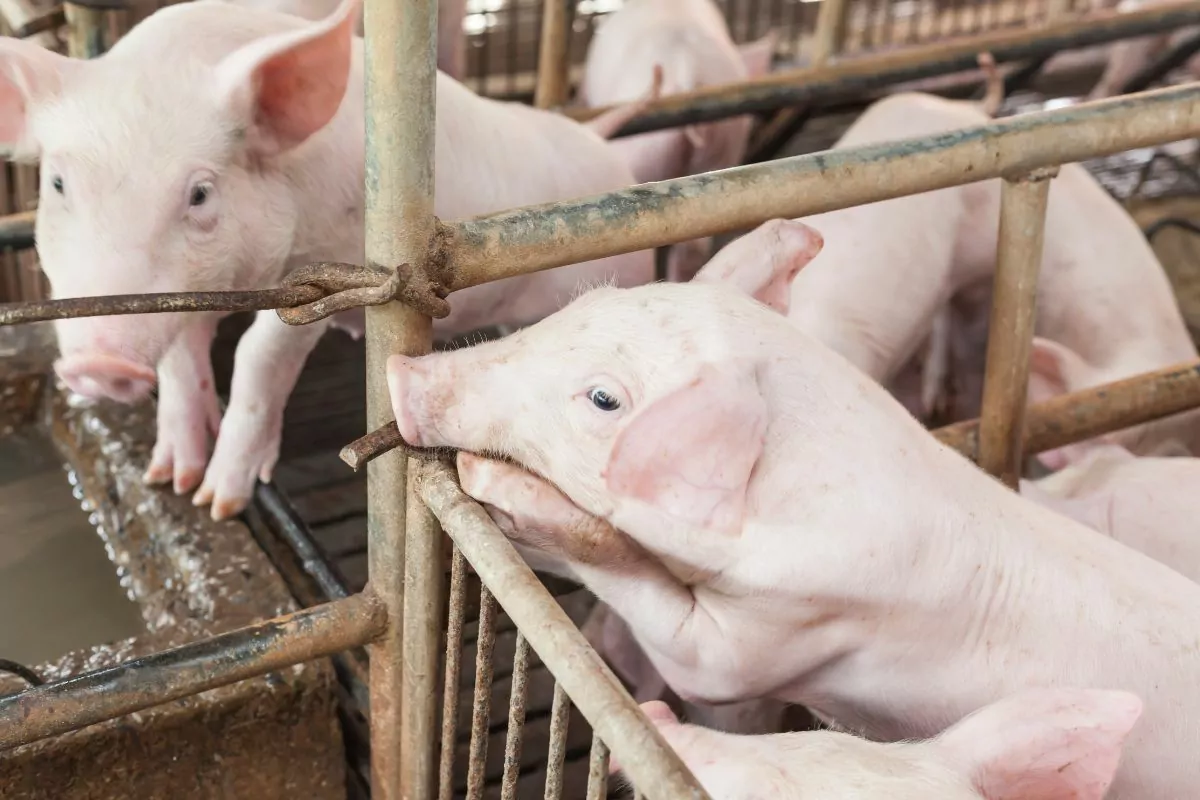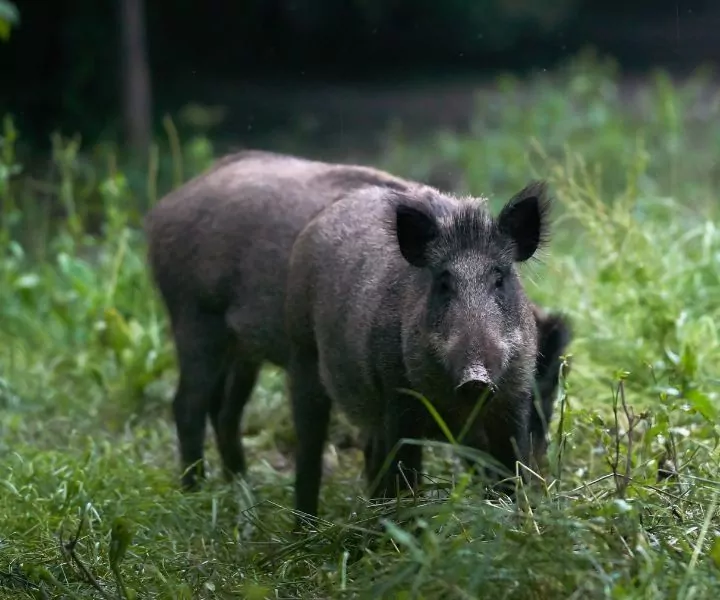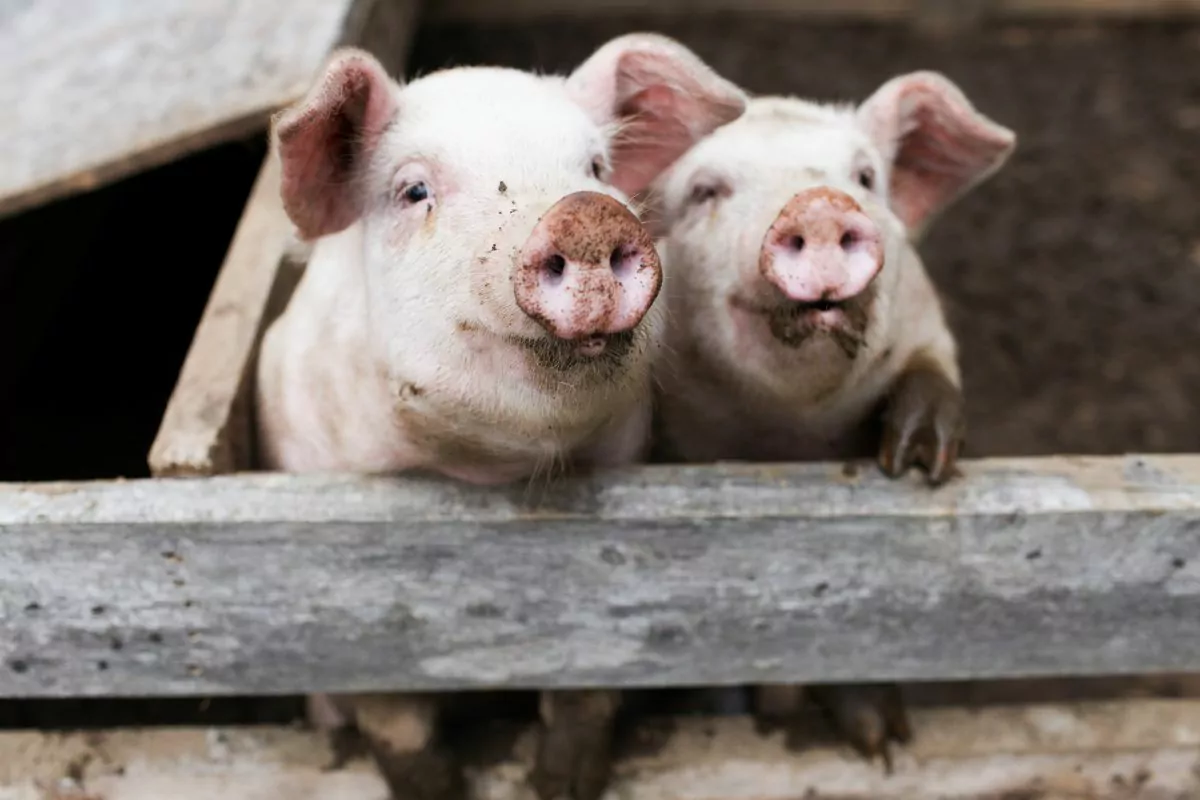We have all heard of a herd of cows or a flock of sheep, but what do you call a group of pigs? Is it a herd of pigs, a drove of pigs, or something else entirely?
Read on to find out the answer to this question and other interesting facts about pigs.

What is a Group of Pigs Called?
So, what is a group of pigs called? There are a few different terms that you can use to describe a group of pigs. However, the best and most accurate terms are a drove of pigs or a sounder of pigs. You can as well call it a team of pigs.
These terms are the most accurate because they account for the different types of pigs that exist. For example, a drove of pigs typically refers to younger or fresher pigs, while a sounder or a team of pigs can refer to any pig.
Other terms that you might hear to describe a group of pigs include a passel of pigs, a litter of piglets, a herd of pigs, a farrow of piglets, or a group of pigs.
While these terms are technically correct, they are not as accurate as those mentioned above. I’ll go over the meaning of each of these terms in more detail below, but first, let’s start with the most precise terms.
A Drove of Pigs
As we mentioned above, the most accurate way to describe a group of pigs is by using the term “drove.” You might hear this term used to describe a group of young pigs. If you have adult pigs, you would typically use the term “sounder” or “team” instead.
You can also use “drift” to refer to a drove of pigs. These two terms are interchangeable. So, if you hear someone say “a drift of pigs,” they are referring to the same thing as a “drove.”
A Sounder or Team of Pigs
Another accurate way to describe a group of pigs is by using the terms “sounder” or “team.” You can use these terms to describe any pig, whether young or old.
You might hear the term “team” used more often when referring to a group of pigs working together. For example, if you see a group of pigs pulling a cart, you could describe them as a “team of pigs.”

A Passel of Pigs
The term “passel” is another word you can use to describe a group of pigs. However, this term is not as common as the other terms on this list.
This term specifically refers to a group of baby pigs or piglets. If you have ever seen a group of baby pigs, then you know that they are often very playful and active.
A Litter of Piglets
Another term you can use to describe a group of piglets is “litter.” This term is very common, primarily when referring to recent births.
A litter of piglets typically consists of six to eight piglets. However, some litters have more or fewer piglets.
A Herd of Pigs
We have all heard of a “herd” of cows or a “herd” of sheep. So, it makes sense that you can also use this term to describe a group of pigs. Here’s why.
The term “herd” typically refers to a group of animals that live together in a specific area. Pigs fit this definition perfectly because they often live together in fields. This shows that the pigs have a close bond and are comfortable being around each other.
A Farrow of Piglets
And what is a group of baby pigs called? You can use the term “farrow” and “litter” interchangeably. Both terms refer to a group of piglets that are born at the same time.

A Group of Pigs
So what is a group of wild pigs called? The term “group” is the most general term on this list. You can use it to describe any type of pig, whether young or old. Most people use this term when they don’t know the specific term for a group of pigs.
For example, if you see a group of pigs and don’t know whether they are young or old, you can describe them as a “group of pigs.” The term “group” is also very versatile. You can use it to describe a small or large group of pigs.
The Scientific Name for a Pig
The scientific name is Sus scrofa (Sus domesticus). Scientists use this name to describe domestic pigs. The domestic pig is the most common type of pig in the world.
Pigs are part of the Suidae family. This family also includes other animals, such as wild boars and hogs. All of these animals are suids.
We’ll go over the differences between these animals later on. Let’s first take a look at the pigs’ life span.
A Pig’s Lifespan
How long do pigs live? The average lifespan of a pig is five to 18 years. However, this number varies depending on the type of pig. For example, domestic pigs typically live longer than wild pigs. This is because they have a better environment and more food. Averagely, a domestic pig will live for 20-plus years, while a wild pig will only live for four to 10 years.
Wild pigs are prone to disease and predators. This is why their lifespan is shorter than domestic pigs.
Pigs in the wild also have to fend for themselves. This means that they have to find their own food and shelter. On the other hand, domestic pigs have humans to care for them. This is why they have a longer lifespan.
So, what is the oldest pig on record? The oldest pig on record was a domestic pig named Baby Jane. Baby Jane was born on 1 February 1998 and lived to the ripe old age of 23 years, 77 days.
Before Jane, the oldest pig on record was another domestic pig named Ernestine. Ernestine lived to be 23 years. Read our article and find out What is Dippity Pig Syndrome in Pigs?
Where Did Pigs Originate?
Pigs originated in Southeast Asia thousands of years ago. They are believed to have been domesticated from wild boars in this region. This historical connection to Southeast Asia has made pigs an integral part of various cultures and cuisines around the world.
When Did the Domestication of Pigs Occur?
The domestication of pigs is thought to be around 16,000 years ago. However, scientists are still debating this number.
The domestication of pigs is still unclear because there are no written records of this event. This makes it difficult for scientists to determine when it occurred.
According to research, the first pigs are from the East (between 8500 and 8000 BCE). Agriculturalists then took these pigs to Europe (between 5000 and 4500 BCE).
In Northern Europe, farmers started incorporating wild boars into their farms. This is because wild boars were a valuable source of meat. The domestication of pigs then spread to the rest of Europe and Asia.
In 1493, Christopher Columbus brought pigs to the Americas. These pigs then spread to South America, Mexico, and the Caribbean.
Pigs are now found all over the world. They are a valuable source of food used in many different cultures. Some cultures even use pigs for religious purposes. Others use pigs for their fur or as pets. How does the pig fit into your culture?
Are Pigs Omnivores?
Is a pig an omnivore? The quick answer is yes; pigs are omnivores.
Pigs are opportunistic eaters. This means that they will eat almost anything they can find. Pigs eat both plant and animal matter.
They can digest both types of food because they have a simple stomach. This type of stomach is similar to the human stomach.
Pigs also have an appendix. This is a small, sac-like organ attached to the large intestine. The appendix helps pigs digest plant matter.
Pigs will eat both fresh and rotten food. This is because they have a strong sense of smell. Pigs use their sense of smell to find food.
They will also eat their own feces (yuck!). This may seem gross to us, but it’s actually beneficial for pigs. When pigs eat their feces, they can extract more nutrients from their food.
Pigs can eat many different things because they have a high tolerance for bacteria. This is why most pigs live in dirty conditions.
Whether you find it gross or not, the fact that pigs can eat so many different things is quite amazing.

How Much Do Pigs Weigh?
Pigs come in all different shapes and sizes. This is because there are many different types of pigs. The size of a pig also depends on its age and gender.
An adult pig weighs between 110 and 770 pounds (50 and 350 kilograms). Domestic pigs typically weigh more than wild pigs.
The largest pig on record was Big Bill. Big Bill weighed in at 2,552 pounds (1,157 kilograms), standing at five feet (1.52 meters) tall and 10 feet (3.05 meters) long!
At birth, a piglet will typically weigh between two and four pounds (0.91 and 1.81 kilograms).
Piglets grow quickly. By six months, they will typically weigh between 150 and 250 pounds (68.04 and 113.6 kilograms).
Male pigs (boars) tend to be larger than female pigs (sows). From birth, sow pigs weigh heavier than boar pigs. However, boar pigs will weigh more than sow pigs by 12 months of age.
What are Piglets?
Piglets are baby pigs. The name of a newborn pig is a farrow. As we said before, the name farrow describes a group of piglets born simultaneously.
A typical litter (the name for a group of piglets born simultaneously) will have between six and 12 piglets.
Piglets are born blind and deaf. They are also unable to walk. For the first few weeks of their lives, piglets rely on their mother for food and warmth. After a few weeks, piglets will start to explore their surroundings. They will also begin to eat solid food.
Piglets grow quickly. They will double their birth weight within the first week of life. By the time they are three months old, piglets will be about the same size as their adult counterparts.
Pig vs. Hog – The Difference

So, what’s the difference between a pig and a hog? To be honest, not much.
Most people use the terms “pig” and “hog” interchangeably. However, there are a few differences between the two.
For starters, hogs are typically larger than pigs. Hogs can weigh an excess of 120 pounds (54.43 kilograms), while pigs typically weigh less than 120 pounds (54.43 kilograms).
The snout of a hog is also flat. This allows them to dig for food more easily. Pigs have a cartilaginous snout. This means that their snout is more flexible.
Hogs also have stocky bodies. This is the result of years of breeding by farmers. Farmers have bred hogs to be this way so that they can sell them more easily. Pigs, on the other hand, have short legs and bristly hair.
Finally, hogs prefer any temperature apart from extreme cold. However, pigs can live in cold climates because they don’t sweat.
So, to sum it up, the main difference between a pig and a hog is their size. The table below provides a more detailed comparison between the two.
| Pig | Hog |
| Pigs typically weigh less than 120 pounds (54.43 kilograms) | Hogs can weigh an excess of 120 pounds (54.43 kilograms) |
| Pigs have a cartilaginous snout | The snout of a hog is flat |
| Pigs have short legs, and bristly hair | Hogs have stocky bodies |
| Pigs can live in a cold climate because they don’t sweat | Hogs prefer any temperature apart from extreme cold |
How Big Do Pigs Get?
Pigs come in all different shapes and sizes. Some miniature pigs weigh as little as 30 pounds (13.6 kilograms), and large breeds can get up to 800 pounds (363.87 kilograms)!
The average weight of a pig is between 110 to 770 pounds (49.9 to 349.27 kilograms), but there is no telling how big or small a pig can get.
A pigs’ weight can also depend on their diet and exercise. If a pig is well-fed and doesn’t get much exercise, it will likely be heavier.
On the other hand, if you have a very active pig that doesn’t eat much, it will likely be on the smaller side.

Other Interesting Facts About Pigs
Before we finish up, we wanted to share some interesting facts about pigs that you may not know. Here are seven interesting facts about pigs:
Pigs are Very Clean Animals
Surprised? We were, too, when we first learned this. Pigs are actually very clean animals. In the wild, pigs will make sure their sleeping area is clean. They will also bathe regularly in water or mud to cool off and keep clean.
Pigs Have Good Memories
Pigs have good memories. They can remember things for up to three weeks!
Pigs are Smarter Than Dogs
That’s right; pigs are more intelligent than dogs. They are one of the smartest animals on the planet. At two weeks, pigs can already recognize their names. Their intelligence is on par with a three-year-old human child. And did you know that pigs can even play video games? Funny, right?
Female Pigs (Sows) Sing to Their Young
Haha, this one is interesting. Female pigs sing to their young while nursing them. The sound is similar to a human hum. Isn’t that adorable?
Pigs Dream
Pigs dream as we do. You may see them twitching or even making little noises while sleeping. This is because they are dreaming!
Pigs Have Four Hooves
Did you know that pigs have four hooves? That’s right, two on each foot. However, pigs only use two of their hooves to walk—the other two hooves for balance.
Pigs Sleep Nose to Nose
Aww, this one is cute. When pigs sleep, they like to sleep nose to nose with their friends. Pigs are social animals, and they love to cuddle.
In Conclusion
We’ve come to the end of this post, and we hope you enjoyed it. So now you won’t wonder anymore what is a group of pigs called.
Pigs are amazing creatures, and we’re sure you learned a lot from reading this post. If you have any questions, feel free to leave a comment below, and we’ll be happy to answer them.
Have a great day!
